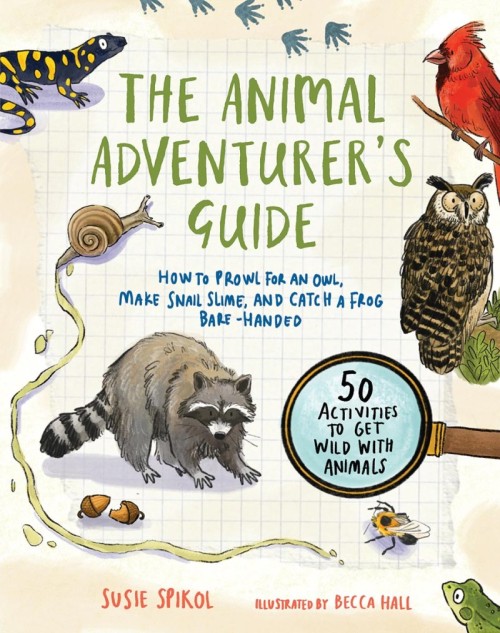by Susie Spikol
Roost Books, 2022
How to Prowl for an Owl, Make Snail Slime, and Catch a Frog Bare-Handed
The Animal Adventurer’s Guide is an irresistible and accessible guide to backyard wildlife. Author Susie Spikol, a naturalist at the Harris Center for Conservation Education in Hancock, New Hampshire, deftly sidesteps common pitfalls of the children’s nature book genre while inviting discovery of self, place, and the intersection thereof.
As a former wildlife biologist, science teacher, and mother of three, I have read my fair share of nature books and guides. Most are filled with stunning photography – and enough description to dash one’s sense of discovery. Many nature books and documentaries, although educational and awe-inspiring, leave children with the sense that wildlife exists in exotic ecosystems and is to be studied by professional scientists, quickly, before humans ruin it all.
Nowhere in Spikol’s 124-page guide is there a disheartening message. Rather, through and within each of its 50 activities, there is recognition of nature as ubiquitous. Even the animals in Becca Hall’s delightful illustrations appear neighborly. The prevailing message is that fascinating wildlife exists everywhere, and that everyone, including and especially children, can discover it.
For each activity, in addition to a list of things needed (mostly inexpensive and common household items), Spikol provides a list of skills needed for the investigation. Herein her brilliance as an educator shines. Taking nothing for granted, she identifies natural tendencies and age-appropriate skills and behaviors: being gentle, being quiet, imagining, sharing with your partner, showing compassion, comparing, sleuthing, collecting data, spying, worm wrangling, participating in citizen science, being brave enough to touch owl barf, and so on. The effect is affirming and empowering. Children can’t help but conclude they already have what it takes to be a scientist.
In addition to celebrating their skill set, Spikol masterfully taps the trifecta of children’s lit: silliness, ick, and awe. What child wouldn’t be drawn in by an activity titled Make Time for Slime or Pow! It’s the Power of Poop? For Get Your Goodall On, Spikol invites children to consider their own wildness and that of other nearby mammals, namely their parents, siblings, and pets. In a few lively sentences she encourages camouflaging, sneaking, and naming based on physical characteristics (as ethologists such as Jane Goodall do), offering “Burper” and “Bed-Head” as examples of the latter. As for awe, after each action-oriented activity, Spikol inserts a sidebar with enough fascinating facts to pique a child’s interest, but not extinguish curiosity for additional exploration.
Children ages 9 to 12 will be able to read The Animal Adventure’s Guide and to complete the activities independently. Spikol does instruct children to seek parental permission and oversight in a few instances. Younger children will require more adult assistance but will not be bystanders, as the materials and procedures are designed to suit little hands and young minds. Although not the target audience, the activities have value for middle and high school-aged students, especially with application of the scientific method; data depiction and comparison; and additional research and experimentation as availed in the sidebars.
Soon after the release of Spikol’s book, I set a copy on my family’s cluttered coffee table. Fewer than 24 hours later, I took my 10-year-old daughter and her friend hiking. As I managed the dogs behind them, I heard my daughter say, “We need to sprinkle a thick layer of flour over the area and place the food in the middle so the animals will have to walk across the flour to get it. Then we’ll return in the morning, see the footprints, and know who’s been there!” Unbeknownst to me, my daughter had picked up the book and read the Set a Track Trap activity. Excitedly, her friend replied, “Yes, and we’ll have to make sure our dogs don’t get out during the night and ruin it.” And there they were, a couple of scientists walking through the woods controlling for variables.


